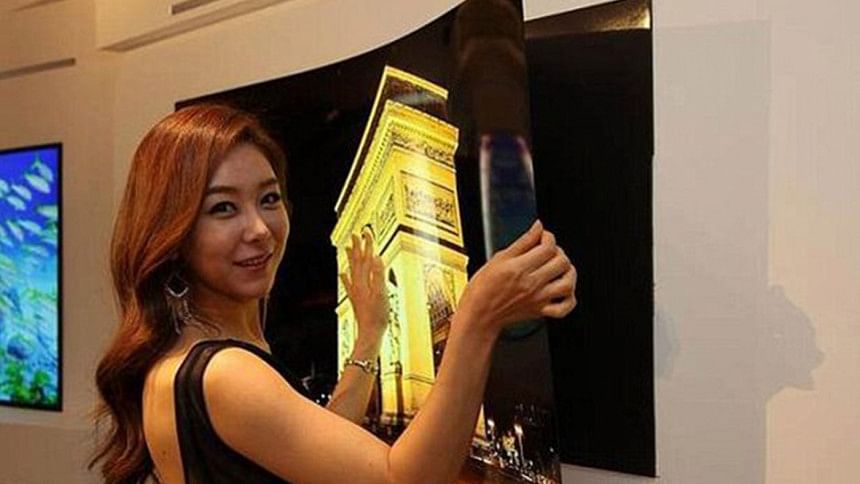LG Display shows off press-on 'wallpaper' TV under 1mm thick

LG Display, the screen-making subsidiary of LG, is dedicated to OLED panels, and it has unveiled an impossibly thin television to prove it.
At a press event in its home country of Korea on Tuesday, LG Display showed off a "wallpaper" proof-of-concept television. The 55-inch OLED (organic light-emitting diode) display weighs 1.9 kilograms and is less than a millimeter thick. Thanks to a magnetic mat that sits behind it on the wall, the TV can be stuck to a wall. To remove the display from the wall, you peel the screen off the mat.
The unveiling was part of a broader announcement by LG Display to showcase its plans for the future. The company said its display strategy will center on OLED technology. According to a press release, the head of LG Display's OLED business unit, Sang-Deog Yeo, said "OLED represents a groundbreaking technology" not only for the company, but also for the industry.
The comments echo the refrain consumers have been hearing for years as display technology has evolved. The HD craze kicked into high gear years ago with technologies like LCD (liquid crystal display) and plasma, but has since been moving increasingly toward LED technology.
OLED is widely believed to be the next frontier. The technology adds an organic compound layer that allows not only for exceedingly thin screens, but for those displays to be curved. The organic material also emits its own light, eliminating the need for a backlight. That allows for such thin screens and has made OLED a desirable choice not only for televisions, but for a wide range of wearables and other mobile products. LG Display believes OLED could be the de facto display technology in all products in the future.
While some OLED screens have been used by companies like Samsung, LG and Sony, the costs are still quite high to produce the displays. Part of that cost is due to a historically low yield, or production of displays that are actually functional. More waste means higher costs on the screens that do make it through production. Those costs are then passed on to consumers. LG's 65-inch, 4K OLED TV, for instance, costs $9,000.
On Tuesday, however, LG said that it has made significant headway in developing OLEDs. The company touted its position as the first to mass-produce large-screen OLEDs for televisions and said that its yield has hit 80 percent -- a strong showing, but still lower than LCDs.
Those issues with yield, coupled with price, mean televisions like the "wallpaper" display might not make their way to store shelves at a reasonable cost anytime soon.
LG Display said Tuesday it expects to sell 600,000 OLED TV panels this year and 1.5 million next year. The company also cited comments made at the press event by Ching W. Tang, a professor at the University of Rochester in New York and "the father of OLED." He said OLED displays will not become ubiquitous for another five to 10 years. At that point, Tang said, they could outpace LCDs in total shipments.

 For all latest news, follow The Daily Star's Google News channel.
For all latest news, follow The Daily Star's Google News channel. 



Comments